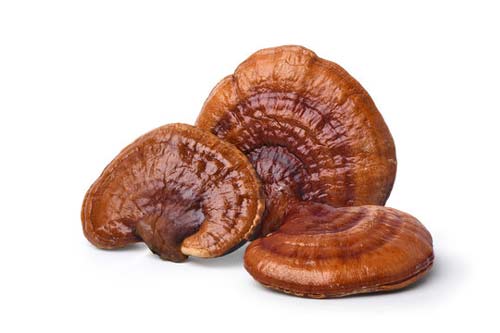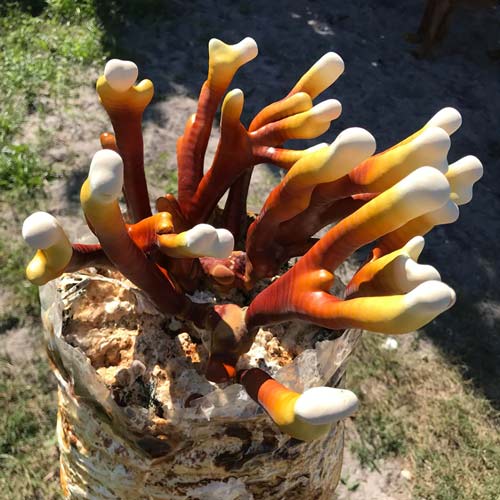Reishi Mushrooms
Reishi mushrooms (Ganoderma lingzhi) are known as the “Mushroom of Immortality” in traditional Chinese medicine and have been held in very high regard for many centuries. They offer a wide range of therapeutic properties and can be used to support the immune system, help the body’s organs and cells adapt to stresses, and promote calm and balance. Reishi mushrooms are one of the most potent medicinal mushrooms yet discovered and their health benefits are impressive.

Reishi mushrooms
Reishi are not edible mushrooms, at least not unless you massively enjoy chewing cork!
Reishi can be grown in two different forms, namely the conk form (with a big cap) and the antler form (tall and spindly), depending on the amount of fresh air they get during fruiting. Reishi mushrooms naturally take on the ‘conk’ form unless grown in a high CO2 environment, which cause them to form antlers. The top of the mushroom is shiny, and is typically red/orange. Reishi mushrooms don’t have gills under their caps like other species, but have pores from which brown spores are released. There are a number of different reishi species, and each grows in a different region around the world. Despite differing appearances, their medicinal properties are the same. Naturally, Reishi mushrooms grow on trees that are dead or dying and continue growing every year until the wood has completely rotted away.
Reishi are easy to identify because they have quite a unique appearance with a deep red body and colors that lighten to orange, yellow and white toward the edges of the cap.
While they’re technically edible – insofar as they can be safely eaten – reishi mushrooms are way too woody and tough to eat. Even finely diced and cooked, they’ll be less tasty than the cork from an old wine bottle. And that’s the young ones; mature reishi mushrooms have a hard outer shell that makes them completely inedible.
The traditional way of consuming reishi is to make it into a tea. But don’t confuse it with the sort of tea you’ll make and share with friends or enjoy for breakfast. Fresh reishi mushrooms need to be boiled for half an hour to extract all of the medicinal compounds and dried reishi will need to be boiled for an hour or two to achieve the same ends. And then, once you’ve made your reishi tea, you’ll discover that it’s very bitter.
You will only ever drink Reishi tea for its medicinal qualities, not its taste! For that reason, the best way of consuming reishi mushrooms is to convert them into a dry powder and consume it in capsule form (making your own capsules is not terribly difficult).
There seems to be an endless list of medicinal claims that have been made about reishi mushrooms. Some of these claims have been well-studied and proven, while others lack scientific evidence to support them (which isn’t to say they’re unfounded, just unproven). However, lab studies have identified some interesting compounds in reishi mushrooms:
Beta-glucans – These compounds may help stop the spread and growth of cancer cells.
Triterpenes – These have anti-allergy and blood pressure lowering effects.
Sterols – These act as precursors to human hormones in the body.
Reishi mushrooms have been shown to slow blood clotting and another study suggests that reishi extracts can help with urinary tract problems. Other studies claim that reishi mushrooms may be helpful in lowering cholesterol – but this has only been tested on animals. Reishi mushrooms are considered adaptogens, said to help the body resist or cope with physical and mental stress. Finally, reishi may be used to treat diabetes and insulin resistance.
Normal doses of dried mushroom extract will range from about 1.5 to 9 grams a day but, as always when buying supplements, there is often little assurance about the purity and dose of shop-sold supplements, including their active ingredients. The answer is to grow your own reishi mushrooms!
Growing Reishi mushrooms

Antler reishi mushrooms
Although not the quickest of mushrooms to grow at home, Reishi are fairly easy to grow. Reishi spawns well on Rye and other cereal grains such as wheat, and best results come from pasteurized substrates. It can also be spawned on sawdust but this isn’t recommended because it tightly binds the sawdust together, making it difficult to use as spawn. Reishi spawn should be cultivated in bags, not jars, as it can be almost impossible to get it out once it starts colonisation without wrecking it with a spoon. In a bag it’s possible to prevent it binding too tightly and it can be extracted even as a block if necessary.
The best substrate for Reishi mushroom is supplemented hardwood sawdust. It is also possible to inoculate hardwood stumps with Reishi plugs for outdoor cultivation. The mycelium is extremely tough and after full colonization, it often starts turning yellow orange-red. This is entirely normal and not a sign of contamination. It grows best when it is warm, out of direct sunlight and located somewhere where it will remain undisturbed. Reishi can take a long time to mature.
Once your spawn and substrate block is ready to fruit, you wwill see ‘antlers’ form inside the bag on the top of the block. Once the antler has reached desired size you can cut the top of the bag off (don’t breathe inside the bag otherwise you will introduce contaminants) and bring the block into fruiting conditions. The arrival of fresh air (oxygen) will trigger the reishi to start forming spore producing “conks” or caps.
A Reishi block will normally produce only one flush (crop). You should get about 1/2 lb of mushrooms from a 5lb block. The biggest yields will come if you allow the mushrooms to form conks instead of the antler form. This is done by allowing lots of fresh air exchange in the growing environment (the inverse being true also).
Reishi mushrooms should be harvested shortly before they start to drop spores. Reishi mushrooms have a heavy spore load, and if not careful they can cover a grow room with brown spores in no time. Try using a very sharp knife to cut the mushrooms off the block, but you may find you need something akin to shears to cut through tougher examples. Despite being tough, Reishi bruise easily around pore surfaces.
You can dry Reishi mushroom slices with a dehydrator for long term storage.
